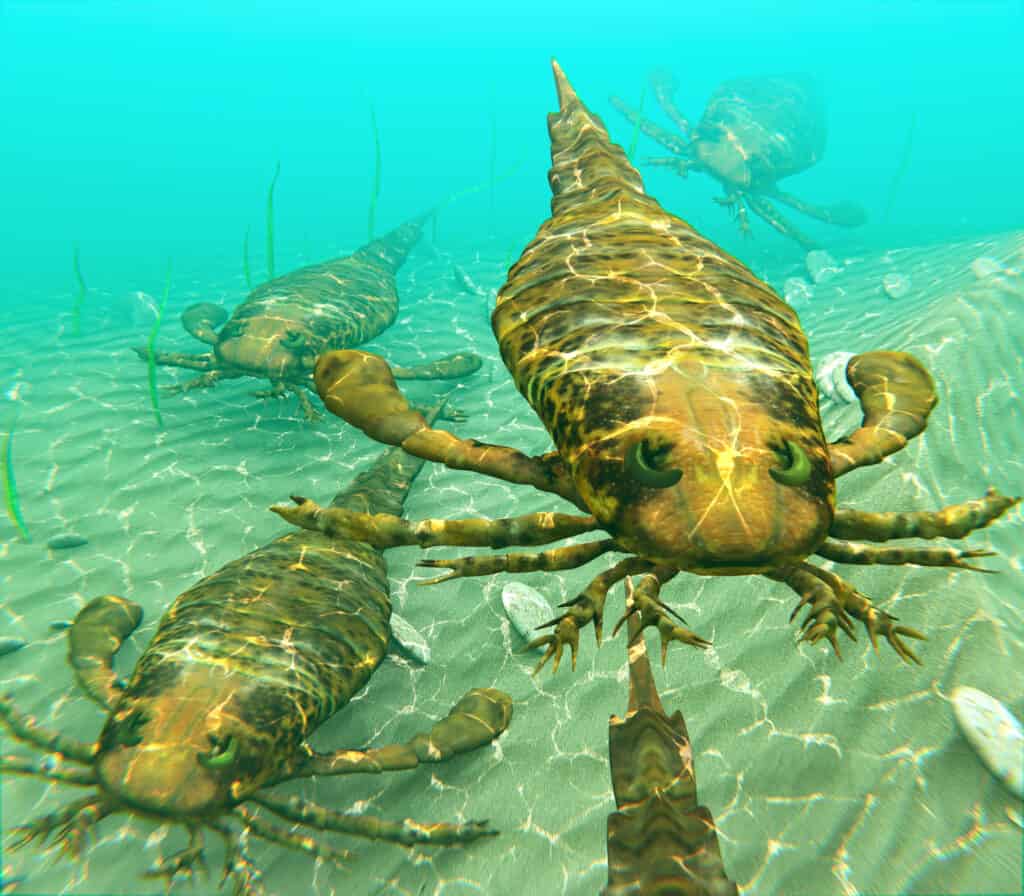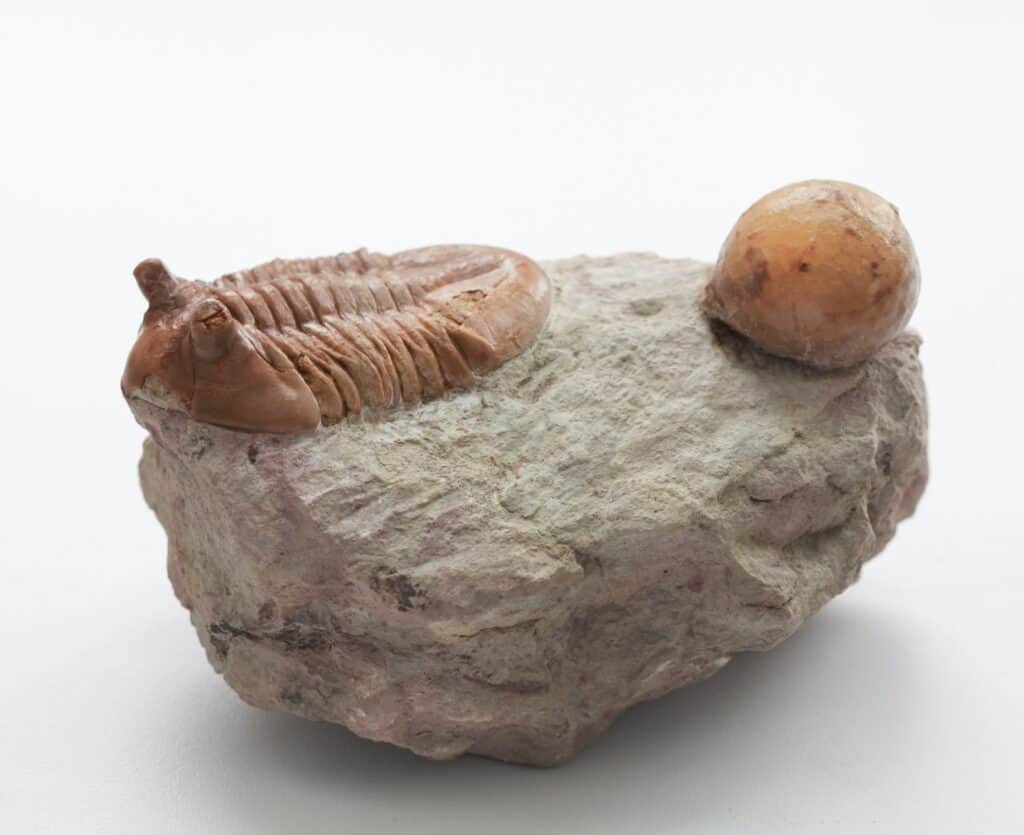The Silurian Period is one of the six geological periods of the Paleozoic era. It followed the Ordovician Period and ended at the beginning of the Devonian Period, lasting an estimated 25 million years. The Silurian Period started about 443.8 to 418.2 million years ago and had some incredible animals.
Following the extinction event that occurred during the Ordovician Period, glaciers from the period melted, causing a rise in the sea levels as the climate became warmer. Vertebrates were still rare, so the main predators of this period were invertebrates. The period is characterized by the dominance of aquatic animals that thrived in the warm rising seas. Here are some of the animals that flourished during the Silurian Period.
Eurypterids

Sea scorpions were one of the main threats to the Cephalaspis.
©Aunt Spray/Shutterstock.com
Eurypterids were a group of aquatic invertebrates that looked like present-day scorpions.They were among the largest arthropods to have ever lived, measuring up to 8 ft in length. There were about 250 species of Eurypterid invertebrates. They are also called sea scorpions or giant water scorpions.
Most of the species lived in shallow estuaries at first, and this set of eurypterids was marine. But as they evolved, many eurypterids moved to freshwater habitats. They were scary predators with large pincers that grasped shelled animals in their habitat.
Eurypterids are among the most common extinct animals in fossil records. They had many features present in present-day arthropods. For instance, they had jointed appendages, and their bodies were covered by a proteinous or chitin cuticle. The aquatic eurypterids used their swimming paddle for movement, while others used their walking legs to move on the seafloor. Eurypterids evolved over the years, and many of their features became modified. They are typically preserved in good condition and found on various continents worldwide.
Trilobites

Like many modern-day arthropods, Trilobites had chitinous exoskeletons, which they shed as they grow.
©iStock.com/Aunt_Spray
Trilobites were one of the first known arthropods and among the most recognizable fossils from the Paleozoic era. The name of this prehistoric arthropod refers to the division of their body into three segments or lobes.
Like many modern-day arthropods, Trilobites had chitinous exoskeletons, which they shed as they grow. These shed exoskeletons (rather than the insect itself) are often referred to as fossils, making them easily traceable even after millions of years. Trilobites were active predators during the Silurian Period. They were mainly scavengers and filter feeders. However, their mode of feeding probably changed over time. Trilobites evolved so many times to fit into the habitat. There were over 20,000 species of trilobites, with the smallest being less than a millimeter and the biggest being 28 inches.
Agnatha

Interestingly, Agnathas (sometimes also called lamprey eels), are not all extinct.
©Panaiotidi/Shutterstock.com
The Silurian Period is known for the evolution of both jawed and jawless fish. However, jawless fish groups like the agnatha were among the most incredible Silurian Period animals. Vertebrates were rare then, and agnathas were among the first sets of vertebrates that lived. There were more than 100 species of this fish with different fossil forms. The absence of a jaw was a standard feature of all species.
Interestingly, agnathas are not all extinct. There are still two groups of jawless fish living today: the Hagfish and lamprey. The hagfish is also called slime eel, which has about 70 species under its name. The lamprey looks like eels but with a jawless sticking mouth that attaches to other fishes.
Cystoids

Cystoid fossils were found in the Mississippi River in various Silurian rocks.
©Fiery Phoenix/Shutterstock.com
Cystoids are extinct echinoderms known for their hard and calcareous exoskeleton. They had an oval shape covered with thecal plates arranged in circles. Cystoids are echinoderms known for the presence of pore openings on their body. The pores could either be distributed evenly along their body or in distinct parts of their body. They were most likely used for respiration as they allowed inward and outward movement of water.
Only a few cystoids were mobile; most lived at the bottom of the sea, stuck to the seafloor. Their fossils were found in the Mississippi River in various Silurian rocks. Modern families of cystoids include sea urchins, sea stars, and sea lilies. Cystoids were on earth for about 130 million years. They evolved in the Ordovician Period, lived through the Silurian, and went extinct during the Denovian Period.
Corals

Corals bleach when stressed due to temperature rise, climate change, and changes in conditions like nutrients and light.
©Jolanta Wojcicka/Shutterstock.com
Corals are invertebrates, and they are of the phylum Cnidaria. They are colorful animals, even though they might be confused with plants because of their structure. They have internal and external calcareous skeletons, and their skeletons are also called corals. Corals live off one another by forming colonies called coral polyps. The polyps form an exoskeleton on one side of their bodies. They are cylindrical, with the exoskeleton on one end and tentacles on the other for feeding and warding off predators.
Corals do not move as they attach themselves to the seafloor permanently. They feed with tentacle-like arms, which direct food toward them by sweeping it into their mouth. Corals are essential parts of the sea ecology because they form reefs that act as food and habitat for about a quarter of fishes in the world.
Corals bleach when stressed due to temperature rise, climate change, and changes in conditions like nutrients and light. They bleach by expelling the symbiotic algae present in their tissues. However, the coral might die if the bleaching process goes on for too long. This is a concern because of the consistent change in climate and temperature rise, making the corals bleach regularly.
Conclusion
The Silurian period saw many plant and animal species come and go; some existed before the period while others adapted and became more established during the Silurian. Although many of the Silurian most incredible Silurian period animals are now extinct, a few persist till today and can still be seen in the world’s oceans.
Up Next
- The Cretaceous Period: Major Events, Animals, and When It Lasted
- The Top 10 Incredible Animals That Live in Coral Reefs
- Discover 5 Incredible Cambrian Period Animals
The photo featured at the top of this post is © Jolanta Wojcicka/Shutterstock.com
Sources
- University of California Museum of Paleontology, Available here: https://ucmp.berkeley.edu/silurian/silurian.php
- LiveScience, Available here: https://www.livescience.com/43514-silurian-period.html
- Cal Poly Humboldt NHM, Available here: https://natmus.humboldt.edu/exhibits/life-through-time/visual-timeline/silurian-period
Thank you for reading! Have some feedback for us? Contact the AZ Animals editorial team.






